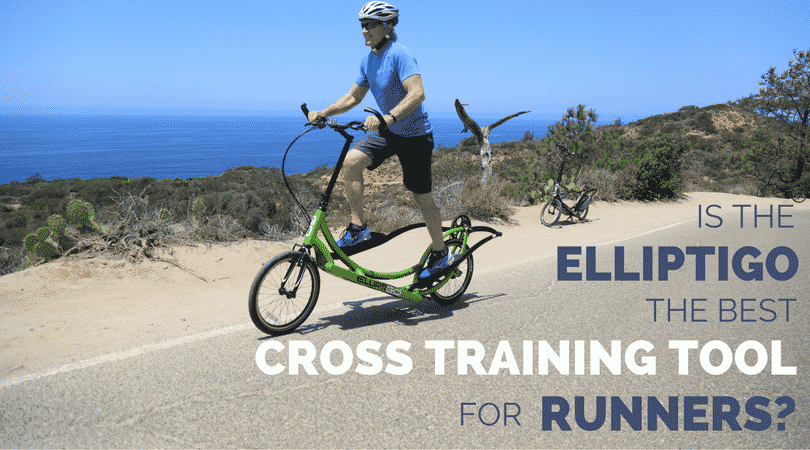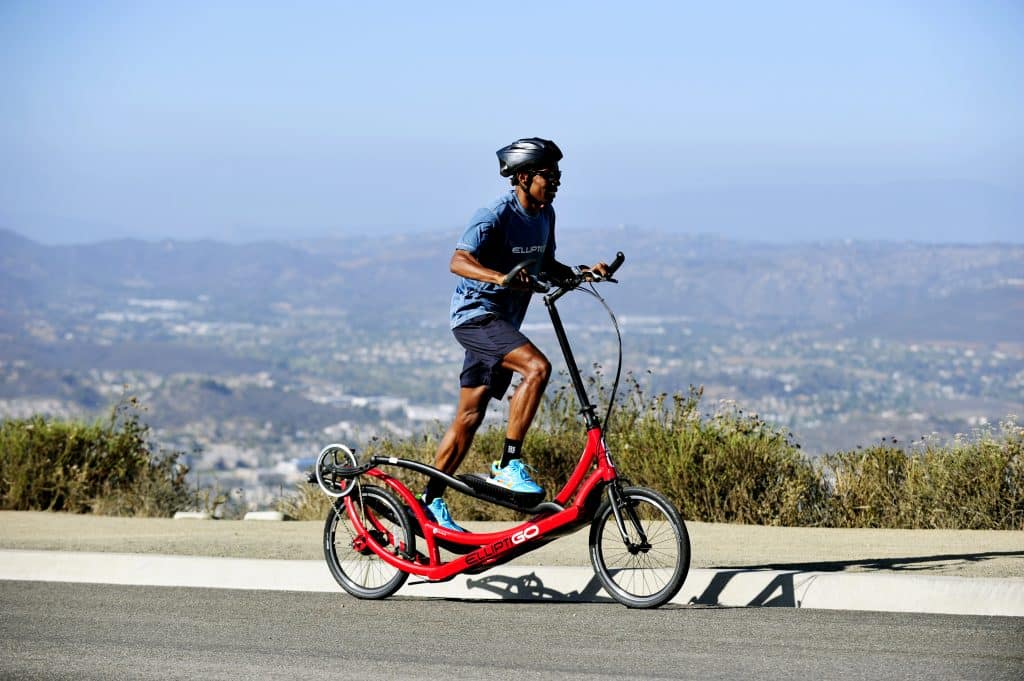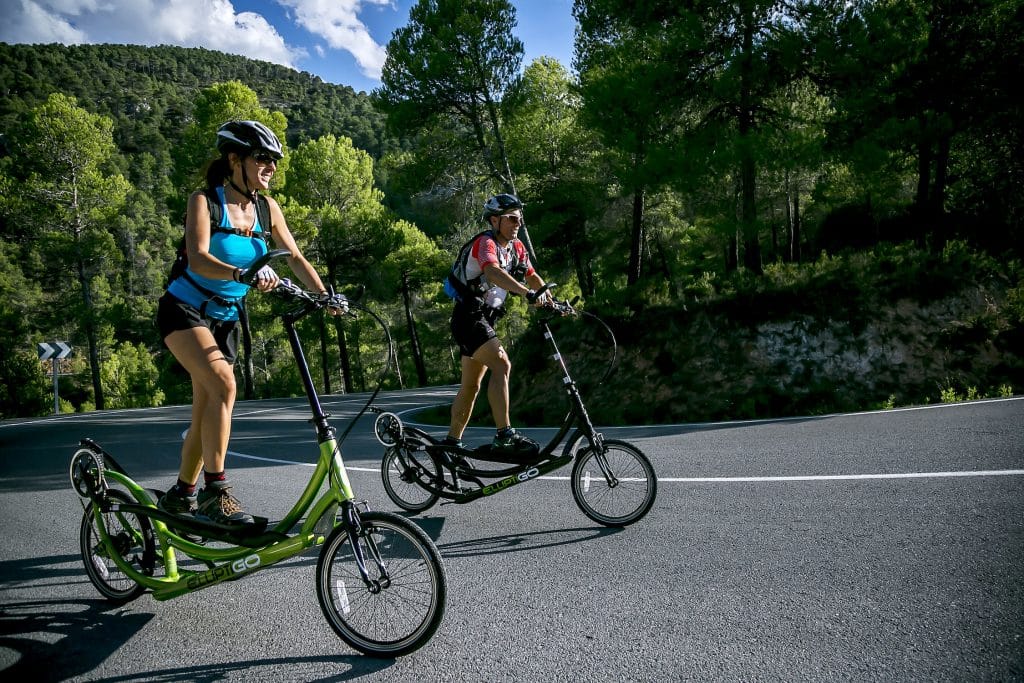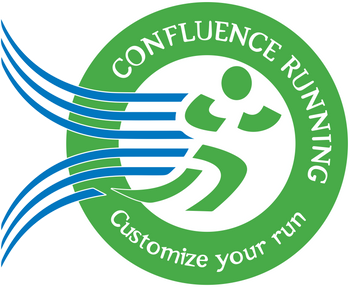You may have seen the strange looking “scooter” on elite runners training pages.
You may have wondered: What does it do? How does it help runners? Why is this so much better than other cross training workouts for runners? Want to find out? Let’s do it!
Schedule an Elliptigo Ride Today

Previous research has shown up to 79% of runners had experienced a running related injury in a 1 year period.
This finding is substantial, but not surprising for runners who incur large impact forces, up to 2-3 times your body weight every step over the course of each run.
This repetitive impact has been seen to be linked to the high injury rates in runners.
Schedule an Elliptigo Ride Today
Once injured, a runner has limited options to maintain fitness and performance levels without incurring further injury.
Cross Training for Runners to Stay in Shape
We have talked about various forms of cross training that can be used to maintain fitness during injury, and we have an entire page devoted to helping each of us stay in shape by cross training when “our turn” arrives.
This guide shows each of the forms of cross training that can be used to maintain fitness, and race well off cross training.
However, there is one form of cross training that is missing from this list.
There is one form of cross training that many runners have not yet tried.
Schedule an Elliptigo Ride Today
There is one form of cross training that looks to be the future of cross training.
The ElliptiGO.
Why an ElliptiGO Review?
You may have heard our ultimate cross training panel podcast last year, where we interviewed one American Record Holder in the Mile (Alan Webb), one Pool Running Olympian Coach (Lynda Huey), and one sub 4:00 miler ElliptiGO expert (Darren Brown).
It was through this podcast where we learned more about the benefits of cross training, and allowed our panel to bounce ideas off one another to give our listeners even more confidence that cross training would get them through the good and the bad times within a running career.
After this interview, we had a lot of interest in ElliptiGO, with many people still not even sure what it was.
We decided it was time to write a post on this form of cross training, and dive into the research to find out just what that had to say about this cross training tool.
That way, we can give you a realistic assessment of whether the ElliptiGO is right for YOU, regardless of what those ElliptiGO reviews say on blogging websites.
Today we are going to look into what it changes about cross training for runners. We are going to find out what the research has found about the effectiveness, to help you compare the ElliptiGO vs running and ElliptiGO vs bike. Finally, we will give practical advice on how every runner can use one in their training if this is the best cross training tool for you.
You know we are all about the science at Runners Connect, so the scholarly research was our first stop.
Whether you are injury prone, looking to reach the next level, or just looking for something new, this article will cover everything you need to know about an ElliptiGO, and leave you looking for excuses NOT to buy one.
Ready to learn more about ElliptiGO?
Schedule an Elliptigo Ride Today
Here we GO!
What is an ElliptiGO?
The ElliptiGO has been designed to provide an outdoor, running-specific, low impact cross-training option for injured and healthy runners.
An ElliptiGO is a combination of a light weight elliptical on wheels with bicycle handlebars and modifications to better emulate the running motion as compared to an elliptical trainer (Outdoor Elliptical Bikes-ElliptiGO, 2014).
Schedule an Elliptigo Ride Today
Why is an ElliptiGO better than the elliptical bike or pool running?
The adjustable stride length of an ElliptiGO is up to 26 inches long which allows for greater hip movement and prevents the shuffling motion often felt on an elliptical.
Consider this:
A running-specific recovery stroke has been designed to position the recovery leg in a downward recovery position, similar to running.
The ElliptiGO does not have a flywheel, which is a mechanical device that uses momentum to assist in rotational movement during exercise on an elliptical. This means there is no assistance other than the power of your legs to propel the ElliptiGO forward.
Most importantly for runners:
The ElliptiGO can be ridden outdoors, which provides a close replication of the running experience as well as the recruitment of balance and stability muscles.
We all know how depressing the idea of an hour staring at a wall in your gym can be when you long to be back outside running!
Schedule an Elliptigo Ride Today
What Does the Research Say About the ElliptiGO?
It’s all very well taking the information from the ElliptiGO website to explain what it is, but is there actually any proof that it is better than other forms?
Recently, a research study from Ohio University compared ElliptiGO-only training (ET) and run-only training (RT) on physiological and subjective variables over two separate 4-week training periods (matched for intensity, volume, and terrain).
This study recruited male and female runners who were healthy, trained, and highly fit in order to participate (ages 22.83 ± 3.33 years old). These runners performed health and fitness testing, including an incremental VO2max test. Those runners who completed the study had on average 9.25 ± 4.73 years of running experience, 10.68 ± 4.79 % body fat, and VO2max values of 57.92 ± 9.68 ml/kg/min.
The type of training was then randomly assigned to each participant and the training prescriptions were representative of a typical in-season distance running program aiming to improve 5,000 meter performance. This training included relative intensities, prescribed based from a participant’s VO2max test, that ranged from below VT (easy, 80% of training) to above RCP (hard, 5%) and in between (medium, 15%) each week.
Participants performed both training periods in a cross-over design and completed identical testing sessions initially, following ET, and also following RT.
Schedule an Elliptigo Ride Today
Cardiovascular benefits
This research reported similar improvements in
- Ventilatory threshold (VT) between ET and RT regardless of which training period was completed first.
- VO2max
- Respiratory compensation point (RCP)
- Running economy (RE)
- 5,000 meter time trial times for either ET or RT
The research reported similar enjoyment and perceived effort (RPE) levels between ET and RT throughout the 4-week training period.
Was the ElliptiGO better than running in any areas?
Researchers noted that those with minor running pains did not experience these while riding the ElliptiGO and ET was rated as enjoyable as running.
One clear difference was the lower amounts of lower body soreness produced during ET compared to RT.
The ElliptiGO’s low impact nature and its ability to be ridden outdoors and produce similar running movements is thought to give reason to these findings.
Participants reported lower body RPE levels during the graded VO2max test following ET, but not RT.
Researchers suggest that these practical findings may have been due to the non-specific low impact nature of the ElliptiGO.
This study used healthy runners who had consistent run training backgrounds prior to their participation. Thus, these results can then be applied to the healthy running population or to the injured population.
The ElliptiGO produced similar physiological and subjective results as compared to running over a 4-week training period in trained and highly fit runners.
How Should Runners Use an ElliptiGO for Training?
You now know what an ElliptiGO is.
You know that it can be used to simulate running, and have even found a dealer near you to test ride an ElliptiGO, but what is the next step?
Well, first you need to decide which model you are going to consider
There are three model types:
The ElliptiGO 3C is the basic model type, with three gears, and is best for those who want to use it for supplemental training on flat ground or lightly rolling hills.
The ElliptiGO 8C has, you guessed it, 8 gears, and is the most popular model for elite runners and recreational runners alike.
If you have had enough of injuries, and want to treat yourself to something you will really enjoy, the ElliptiGO 11RR is the one for you.
What about the training?
If you have an ElliptiGO, but are not quite sure how to use it to stay in shape and keep your running fitness, look no further.
We asked our expert from the cross training panel to give us some training advice on how to use the ElliptiGO in your training, and where it can be used no matter what level you are running at.
How does training on an ElliptiGO keep you fit as a runner?
Based on research conducted at UCSD, ACE, and Ohio University, we have learned a lot about best practices for integrating the ElliptiGO elliptical bike into a regimen to replicate run training.
UCSD and ACE both confirmed that when perceived exertion (PE) is equal between running and ElliptiGO, a similar heart rate (HR) response can also be expected.
What these studies allow us to do, is accurately and effectively substitute and supplement running miles for cross-training volume to prevent injury, maintain fitness during time of injury or increase fitness without increasing the amount of impact-related stress put on the body.
How can the ElliptiGO be used to maintain fitness when injured?
Substituting mileage with time on the ElliptiGO is a great way for injured athletes to maintain fitness or injury-prone athletes to stay healthy without sacrificing volume.
Because the cardiovascular equivalent of workout efforts from running to ElliptiGO biking is converted on just time and intensity, any athlete or coach can easily translate their proposed running session to an ElliptiGO cross-training session.
Athletes like Meb Keflezighi and Sarah Brown have used this method to maintain healthy, consistent training, the key to success and continual improvement.
Schedule an Elliptigo Ride Today

How can the ElliptiGO help with recovery?
Whether it’s an easy run or a shakeout run, most people know “how” to complete an easy run. Few, however, take the time to understand “why” they do these runs. This could be why so many runners struggle to stay easy enough on their recovery runs. We already told you that you can run 23% faster by running 80% easy, but why is it so important?
There are two main reasons why runners complete these runs: to increase aerobic volume and to enhance recovery.
Higher-intensity workout sessions can leave the body fatigued and tight.
In an effort to flush the body of these symptoms and properly recover – while also boosting weekly volume – many athletes incorporate second/shakeout runs in the afternoon, followed by an easy day or two.
The problem is that these second efforts and consecutive running days can prove to be too much for some runners, acting as the straw that breaks the camel’s back, and leading to injury.
By replacing these efforts with ElliptiGO rides, athletes can remove the additional impact stress of those runs, while still receiving all the physiological benefits.
How do the elite runners use the ElliptiGO?
Need an example?
Having dealt with Achilles issues in the past, professional 1500m Sarah Brown no longer does second runs and only runs 6 days per week.
Instead, she turns to the ElliptiGO in the afternoons and the day after her long run, an approach which has helped her keep volume up, while also staying healthy.
This balance has led to PR’s across all events from 800m to 8km.
Similarly, as his body has aged, Meb Keflezighi has also turned to elliptical cycling for second run efforts as a way to limit his mileage without sacrificing volume. Meb even extends his ElliptiGO bike sessions to one hour plus as a means of increasing his total volume, despite a lower weekly running mileage.
Still not convinced?
Why is the ElliptiGO good for increasing cardiovascular fitness?
Supplementing mileage is also a valuable use of the ElliptiGO for athletes who wish to safely increase aerobic volume without increasing impact-related structural stress.
This approach has broad application for young athletes building their cardiovascular engine, seasoned athletes looking to boost performance, or even injured athletes returning to training.
For young runners or runners moving up in distance, volume is king, but patience is key.
Bumping up in mileage too quickly can lead to injury, illness and other setbacks.
Using the ElliptiGO to build volume without rushing mileage is a good way to get a safe bump in fitness.
Similarly, seasoned athletes who are at their mileage limit, but want to see performance improvements can use elliptical cycling to reach new levels of fitness – even so much as adding an additional low-impact / high-intensity session to their weekly routine.

Lastly, athletes coming back from injury are not only able to reach higher volumes of training more quickly with elliptical cycling integration, but can even begin to boost their anaerobic and threshold fitness with higher-intensity elliptical cycling sessions much sooner than their body may be prepared to run those efforts.
Pro 5k/10k athletes and Dutch National Record Holder, Susan Kuijken frequently uses sessions like this to safely re-build volume and fitness after time off or a small injury that caused her to back off training.
Can the ElliptiGO be used instead of a regular run?
Some athletes prefer to use the ElliptiGO to both supplement and substitute fitness.
For athletes who have a hard time managing high mileage weeks or workouts, the ElliptiGO chaser allows an athlete to maintain a high volume of cardiovascular work, but without the risk of impact-related injury that can occur as fatigue causes form to break down.
To complete an ElliptiGO Chaser, simply divide an effort into two parts with the exact split being based on individual needs and preferences.
For example, if an athlete had a 90minute run, they may split the run into two efforts of 60min and 30min, completing the first 60min as a run and then jumping directly onto the ElliptiGO for an additional 30min of low-impact exercise.
This is important:
Be sure to ride at an equal HR/PE as running to achieve the same physiological stimulus.
This reduces the risk of impact-related fatigue, while maintaining all the benefits of a 90min effort.
How can runners use an ElliptiGO for hard workouts?
Similarly, an athlete who may want to do 6x1mi repeats, but whose body is only ready to accomplish 4x1mi, can still get the benefit of the full session by completing the last two “mile repeats” on the ElliptiGO.
This is done by matching the time of each repeat – say 5min – and the intensity of that repeat – say 180bpm – with the assigned rest/recovery between – say 2min.
By doing the last two 5min repeats on the ElliptiGO at 180bpm with 2min rest in between, the athlete will accomplish the same metabolic, cardiovascular, and physiological benefits as if he/she had run the final two, but with less risk of impact-related injury.
Schedule an Elliptigo Ride Today
Here’s the deal:
The studies from UCSD, ACE and Ohio University have provided a simple equation that allows runners of any ability to translate running workouts into elliptical cycling sessions with ease, allowing them to train harder AND smarter.
Simply by matching time and intensity, an athlete can stay consistent and healthy, the keys to higher fitness and personal improvement.












